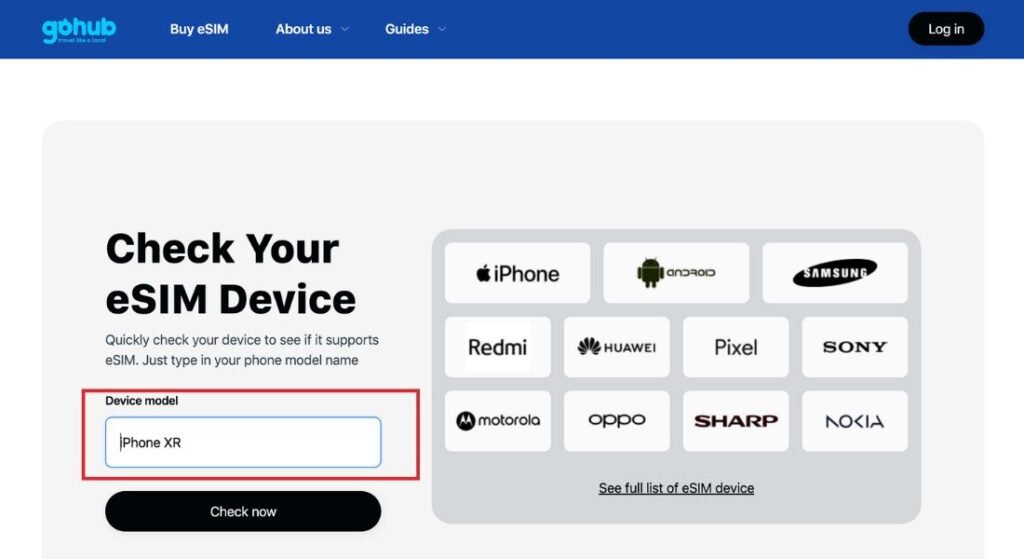Ever landed in a new country, desperately needing Google Maps… but stuck with no signal, a locked phone, and a missing SIM ejector tool? 🙃 Yeah, same here.
In 2025, staying connected while traveling isn’t optional — it’s essential. That’s where travel eSIMs come in. These embedded digital SIM cards work with a growing list of eSIM-compatible phones, tablets, and even laptops, letting you skip the plastic and connect instantly — no roaming fees, no airport SIM drama.
This guide is your all-in-one resource for navigating the world of eSIM-compatible devices, updated for April 2025. Whether you’re a digital nomad, a frequent flyer, or just need TikTok to load on a mountaintop, understanding which devices support travel eSIMs will save you time, money, and stress.
So no, this isn’t just another list of eSIM compatible phones — it’s your travel tech lifeline. Let’s dive in and unlock the world, one eSIM at a time.
I. Why the Buzz About eSIMs? Understanding the Benefits
Okay, so why is everyone raving about eSIMs lately — and not just the tech bros on Reddit?
Imagine this: You’ve just landed in Tokyo. Instead of wandering around Narita Airport looking for a SIM kiosk (with suitcase in one hand and jet lag in the other 😵💫), you whip out your phone, tap a few buttons, and boom — you’re connected. That’s the magic of eSIM.
Whether you’re exploring ancient temples in Kyoto, closing deals in Singapore, or working remotely from a beach bar in Bali, here’s why travel eSIMs are taking over:
- ✨ Total Convenience: No more fiddling with tiny SIM trays or hunting for paperclips. Everything’s managed digitally through your device. Easy peasy.
- 🌐 Seamless Network Switching: Arrived in a new country? Switch to a local plan in minutes. No roaming fees, no stress.
- 📱 Multiple Profiles, One Device: Store work, personal, and travel eSIMs all on the same phone. Most devices let you switch between them easily.
- ✈️ Perfect for Travelers: Activate your eSIM before takeoff or right after landing. No more overpriced airport SIMs or mystery data charges from your home carrier.
- 📶 Dual SIM Power: Many devices let you use both a physical SIM and an eSIM at the same time — super handy for keeping your main number while using local data.
- 📏 Slimmer Devices: Without a SIM tray, phones can be slimmer, lighter, and more durable. Great news for minimalists (or clumsy backpackers like me 😅).
- 🛡️ Bonus Security Points: Because the eSIM is embedded and not easily removable, it can offer added protection if your phone is lost or stolen. (Still… maybe don’t test this.)
TL;DR? eSIMs offer flexibility, freedom, and fewer headaches — exactly what travelers need in 2025.
And if you’re wondering “Okay but… will it work on my phone?” — don’t worry. That’s exactly what we’re about to explore next. 👇
II. Is My Device eSIM Ready? The Essential Compatibility Check ✅
So you’re sold on the magic of eSIMs (who wouldn’t be?), but now comes the million-dollar question:
“Is my phone even eSIM compatible?” 🤔
Don’t worry — we’ve all googled that in a rush at the airport. Let’s break it down so you can know for sure before buying your travel eSIM.
A. How to Check If Your Phone Supports eSIM
Here are a few simple ways to find out if your phone is part of the eSIM-compatible phones club:
1. Dial Code Check
- Open your phone app and dial
*#06# - Look for something called an EID (Embedded Identity Document)
👉 If you see it = good news, your device likely supports eSIM!
⚙️ 2. Check Your Settings
- iPhone: Go to Settings > Mobile Data > Add eSIM
- Android (Samsung, Google, etc.): Try Settings > Connections > SIM Card Manager, or look for “Add eSIM” or “Download SIM profile”
⚠️ Note: These paths can vary slightly by phone model and software version.
📱 3. Use an eSIM App (like Gohub 😉)
If you’re shopping for an eSIM through Gohub or another trusted provider, we’ll often show compatibility right on the product page — no guessing games needed.
4. Check the Official Device Specs
Head to the manufacturer’s website and search your exact model. This is especially important for brands like Huawei, Xiaomi, or Samsung, where eSIM support may vary by region.
5. Instantly Check if Your Phone Supports eSIM — with Gohub
Instead of digging through your settings or searching random forums, just use the Gohub eSIM Device Checker — it’s fast, free, and made exactly for this.
In under five seconds, you’ll know whether your phone is eSIM-compatible and ready for a travel eSIM. All you have to do is type in your device name — we’ll do the rest. No tech skills needed, no guessing.
👉 Check Your eSIM Device Instantly

Image: Check your eSIM device screenshot
⚠️ B. Common Compatibility Gotchas (Read Before You Buy)
Even if your phone model supports eSIM, here are a few curveballs that might trip you up:
- 🔓 Your Phone Must Be Unlocked:
If your device is still locked to a carrier (e.g. Verizon, Telstra), you won’t be able to install an eSIM from another provider.
👉 Check your unlock status or ask your original carrier to unlock it. - 🌍 Region Matters:
Phones sold in China, Hong Kong, or Taiwan often don’t include eSIM functionality — even if the same model in the US or EU does. - 🧩 Some Models Just Don’t Have It:
- Example: Huawei P40 Pro+ → no eSIM
- Samsung FE (Fan Edition) phones → mostly not eSIM compatible
- iPhone models before XR → nope.
- 🔧 Jailbroken / Rooted Phones:
If you’ve modded your device, eSIM might not play nice.
📃 C. TL;DR Compatibility Tips
✅ Check for EID
✅ Go into your SIM/Mobile settings
✅ Make sure your phone is unlocked
✅ Know your phone’s region
✅ Cross-check our 2025 eSIM Compatibility List in the next section 👇
Next Up:
Let’s dive into the ultimate, up-to-date list of eSIM-compatible phones, tablets, laptops, watches — and yes, even cars. 🚗📱💻⌚
III. The Ultimate List of eSIM Compatible Phones (2025 Edition) 📱
So your phone passed the compatibility check? Nice. Now let’s confirm it’s on the official list. We’ve compiled the most updated and travel-relevant list of eSIM-supported phones as of April 2025 — organized by brand, with notes on regional quirks and model exceptions. Bookmark this for your next trip!
Apple iPhones – Most Reliable for eSIM
All models from iPhone XR and newer support eSIM.
✅ Compatible iPhones:
| Model | eSIM Support | Notes |
|---|---|---|
| iPhone XR / XS / XS Max | ✅ | First iPhones with eSIM |
| iPhone 11 / 11 Pro / Pro Max | ✅ | Full support |
| iPhone SE (2020 / 2022) | ✅ | Compact, eSIM-ready |
| iPhone 12 / 13 / 14 / 15 / 16 Series | ✅ | All models support eSIM |
| iPhone 14+ & 15+ | ✅ | Dual eSIM (no physical SIM in US models) |
| iPhone 16e | ✅ | Budget model with eSIM |
| iPhones from China / HK | ❌ | Most models don’t support eSIM |
⚠️ Regional Notes:
- iPhones sold in mainland China and most of Hong Kong do not support eSIM.
- Exception: Hong Kong iPhone 13+ dual-SIM physical models may support eSIM if purchased internationally.
Samsung Galaxy Phones – eSIM Compatibility Guide
✅ Compatible Samsung Models (Global or US/EU variants):
| Model Series | Compatible Models | Notes |
|---|---|---|
| S Series | S20, S20+, S20 Ultra S21, S21+, S21 Ultra S22, S22+, S22 Ultra S23, S23+, S23 Ultra S24, S24+, S24 Ultra S25, S25+, S25 Ultra | ✅ Most models support eSIM globally ❗ US versions of Ultra models may vary |
| FE Series | S23 FE, S24 FE | ⚠️ eSIM support depends on region (EU/Global usually OK, HK/China no) |
| Note Series | Note20, Note20 Ultra | ✅ Global models supported ❗ US & HK Ultra models may lack eSIM |
| Foldables | Z Fold2, Fold3, Fold4, Fold5 Z Flip3, Flip4, Flip5 | ✅ eSIM supported in global models ❗ HK/US variants may not support |
| A Series | A35 5G, A36 5G A54 5G, A55 5G, A56 5G | ✅ Selected newer models only ❗ Check for “Add eSIM” in settings |
| Rugged | Xcover7 | ✅ Supported |
| Tablet | Galaxy Tab Active5 | ✅ Enterprise-level support |
⚠️ Regional & Model Notes:
- Most Samsung phones from China, Hong Kong, Taiwan do not support eSIM — even if the same model in the US or Europe does.
- “FE” (Fan Edition) models have mixed support. Double-check your specific region.
- US versions of some Ultra/Fold models might not support eSIM if bought through carriers.
Google Pixel Phones-eSIM Compatibility Guide
Google was an early eSIM adopter — most Pixels from 2018 onward have great eSIM support.
✅ Compatible Pixel Models:
| Model | eSIM Support | Notes |
|---|---|---|
| Pixel 2 / 2 XL | ⚠️ Limited | Only supports eSIM with Google Fi |
| Pixel 3 / 3 XL | ⚠️ Region-specific | Excludes models from Japan, Australia, SE Asia, and non-Google Fi US carriers |
| Pixel 3a / 3a XL | ⚠️ Region-specific | No eSIM in units from Japan, SEA, Verizon |
| Pixel 4 / 4 XL / 4a 5G | ✅ | Full eSIM support |
| Pixel 5 / 5a | ✅ | Consistent across markets (except HK) |
| Pixel 6 / 6 Pro / 6a | ✅ | Stable support |
| Pixel 7 / 7 Pro / 7a | ✅ | Full compatibility |
| Pixel 8 / 8 Pro / 8a | ✅ | Dual eSIM functionality supported |
| Pixel 9 / 9 Pro / 9 Pro XL | ✅ | Latest models with advanced eSIM support |
| Pixel Fold / Pixel 9 Fold | ✅ | Foldable line supports eSIM |
⚠️ Heads-up: All Pixel phones sold in Hong Kong do not support eSIM. Double-check regional variants before purchase.
Other Popular eSIM-Compatible Phones in Asia & Beyond
Here are more great options if you’re using a Huawei, Xiaomi, or other Android brand popular in Asia.
📱 Huawei Phones – eSIM Compatibility Guide
| Model | eSIM Support | Notes |
|---|---|---|
| P40 / P40 Pro | ✅ | Global models only |
| Mate 40 Pro | ✅ | eSIM-ready |
| P50 Pro | ✅ | Some markets only |
| Mate Xs 2 / X2 | ✅ | Foldables with eSIM |
| P70 / P70 Pro / P70 Art | ✅ | Latest flagship series |
| P40 Pro+ | ❌ | No eSIM support |
| Devices bought in China | ❌ | Not eSIM compatible |
📱 Xiaomi Phones – eSIM Compatibility Guide
| Model | eSIM Support | Notes |
|---|---|---|
| Xiaomi 12T Pro | ✅ | Only the Pro version supports eSIM |
| Xiaomi 13 / 13 Lite / 13 Pro | ✅ | eSIM-ready |
| Xiaomi 13T / 13T Pro | ✅ | Full support |
| Xiaomi 14 / 14 Pro | ✅ | Newest flagship with eSIM |
| Redmi Note 13 Pro+ / 14 Pro+ | ✅ | Some regional models only |
| Redmi 13C / Xiaomi 14 Ultra | ❌ | Not compatible |
| Check device settings | ⚠️ | Feature varies by market – look for “Add eSIM” option |
📱 Motorola Phones – eSIM Compatibility Guide
| Model | eSIM Support | Notes |
|---|---|---|
| Moto G34 / G35 / G54 / G75 / G85 | ✅ | Mid-range models with eSIM (2024–2025) |
| Edge 40 / 50 series | ✅ | Includes Fusion, Neo, Pro, Ultra |
| Razr 40 / 50 / 2024 / Ultra | ✅ | Foldable lineup with eSIM |
| ThinkPhone 25 | ✅ | Flagship with enterprise focus |
| Moto G52J / G53J / G84 | ✅ | Japan & global markets |
📱 OPPO Phones – eSIM Compatibility Guide
| Model | eSIM Support | Notes |
|---|---|---|
| Find X3 / X5 / X8 / X8 Pro | ✅ | Flagships with eSIM (varies by region) |
| Find N2 Flip | ✅ | Foldable with eSIM |
| Reno 5A / 6 Pro 5G / 9A | ✅ | Japan & select APAC models only |
| Find X5 Lite / OPPO Lite models | ❌ | No eSIM support |
| Check region-specific specs | ⚠️ | Japan usually has best support |
🎮 Sony, Honor, Vivo & Others
| Brand | Compatible Models | Notes |
|---|---|---|
| Sony Xperia | Xperia 10 III Lite / 10 IV / 10V / 1 IV / 1 V / 1 VI / 5 IV / 5 V / 10 VI / Ace III | ✅ eSIM across latest lineup |
| Honor | 90, 200 Pro, Magic 7 Pro, Magic V2/V3, Magic6 Pro, X8 | ✅ Regional variation applies |
| Vivo | X90 Pro, X100 Pro, V29, V40 series | ✅ Mostly EU/Asia models |
| Nokia | XR21, X30, G60 5G | ✅ Mid-range with eSIM |
| Rakuten / Sharp / Fairphone | Multiple models | ✅ Mostly Japan or eco-conscious users |
💡 Pro Tip: If you’re not sure about your specific variant, just go to Settings > Mobile Network > Add eSIM — if the option’s there, you’re golden! ✨
IV. Using eSIMs for Travel: A Practical Guide
Let’s be real — one of the best things about eSIMs is how stupidly convenient they are when you’re on the road.
No more getting ripped off at the airport, hunting for a paperclip to open your SIM tray, or panicking because the free airport Wi-Fi wants your life story before it lets you connect. With eSIM, staying online across countries is as easy as tapping a few buttons.
🌐 Step 1: Choose a Travel-Friendly eSIM Provider
Start by picking an eSIM provider that suits your itinerary. Look for ones that offer wide coverage, instant activation, and user-friendly installation. Gohub, for instance, gives you access to data plans in over 100 countries, priced up to 50% cheaper than other global eSIM platforms — and it’s built specifically for travelers.
📲 Step 2: Purchase and Install the eSIM
Once you’ve picked your plan, you’ll receive a QR code or activation link by email or within the app. All you need to do is go into your phone’s settings, tap “Add eSIM,” and either scan the code or enter the details manually. Most setups take less than five minutes — perfect for prepping before a flight or while sipping your last latte at the departure gate.
🛬 Step 3: Activate When You Land
Most eSIMs don’t start working until you’ve arrived and connected to a local network. That’s your cue to head back into your mobile settings, enable the eSIM, and make sure data roaming is on. If you’re using Dual SIM, you can keep your home number active for calls or SMS, while the eSIM handles all your data — super handy for OTPs or WhatsApp.
🔁 Step 4: Switch Easily Between Countries
One of the best parts? You don’t need a new SIM card in every country. Modern phones let you store multiple eSIM profiles and switch between them with just a few taps. So whether you’re crossing borders by train in Europe or backpacking across Southeast Asia, your connectivity follows you.
🤔 Step 5: What About My Phone Number?
If you want to convert your main number into an eSIM, that’s possible — but it depends on your home carrier. Most travel eSIMs (like Gohub’s) are data-only and designed to keep things simple while abroad, without affecting your regular number.
🧩 Step 6: Troubleshooting 101
Having issues? First, make sure your phone is unlocked and connected to Wi-Fi during installation. If your QR code doesn’t work, try a manual setup instead. And if you’re still stuck, Gohub’s support team is available 24/7 to rescue you from airport-Wi-Fi purgatory.
With travel eSIMs, you land ready — no stress, no roaming fees, no SIM trays. Just data, right where you need it.
V. eSIM Tech & Security — What You Actually Need to Know
You don’t need to be a tech geek to appreciate what makes eSIMs so powerful — but a little behind-the-scenes magic never hurts. Especially when you’re trusting your phone to connect in the middle of rural Japan or on a dodgy hostel Wi-Fi in Prague.
So let’s unpack what’s going on under the hood of your travel eSIM — in human language.
🧠 What Is an eSIM, Technically?
At its core, an eSIM is a tiny rewritable chip embedded directly into your phone, tablet, or smartwatch. It does the same job as a regular SIM card — identifies your device on a mobile network — but without needing a plastic card you pop in and out.
Unlike traditional SIMs that lock you into one carrier (and usually come with roaming charges that make your wallet cry), eSIMs can be reprogrammed remotely. That’s what lets you switch carriers, download new profiles, or activate international data — all without touching a single tray.
In short, eSIM = more freedom, less fiddling.
🛡️ Is It Secure?
Yes — in many ways, it’s more secure than physical SIMs.
Since eSIMs are embedded directly into your device, they’re harder to remove, clone, or tamper with. If your phone is stolen, it’s not as simple as yanking out the SIM and disappearing off-grid. And because everything is digital, you’re less likely to lose important access while traveling.
Of course, security also depends on your provider and how you manage things like QR codes or public Wi-Fi. But using a travel eSIM from a trusted source like Gohub adds another layer of protection — no shady SIM stalls, no weird network configurations, and no stress.
⚙️ Who Makes the Rules?
Behind the scenes, GSMA (the global mobile standards authority) creates the rules that keep eSIMs secure, standardized, and compatible across phones and providers. So whether you’re using a Pixel in Canada or a Samsung in Thailand, your eSIM-compatible phone follows a global blueprint.
🔄 What About iSIM?
Coming soon to a phone near you: iSIM (integrated SIM) — the next evolution of eSIM. Instead of being a separate chip, iSIM is built directly into your phone’s main processor. It’s smaller, faster, and opens the door to even more compact, connected devices.
For now, though, most phones (including those in our list of eSIM compatible phones) still run on traditional eSIM tech — and that works just fine for traveling smart in 2025.
Next up: choosing the best eSIM provider for your needs, wherever you go.
VI. Choosing the Right eSIM Provider for Travel
With so many eSIM platforms out there, picking the best eSIM for travel can feel like scrolling through a menu in a language you don’t speak — confusing, overwhelming, and full of fine print.
Here’s how to make the smart choice.
Coverage: Where Are You Going?
Start by asking the most obvious question: does this provider actually work where you’re going? Some eSIM companies offer impressive global coverage, while others focus on regional bundles. Gohub, for instance, partners directly with local carriers in over 100 countries, which means faster speeds and more reliable connections — especially in places where typical “global” eSIMs fall flat.
Value: What Are You Really Paying For?
Price tags can be deceiving. A cheap plan might only include 1GB at 3G speed or expire in 3 days, while a slightly more expensive option offers faster data, broader coverage, and longer validity. With Gohub, pricing is straightforward — no hidden fees, no activation charges, and often up to 50% cheaper than big names like Airalo or Holafly. It’s not just about low prices, but fair value.
Usability: Can You Actually Set It Up?
When you’ve just landed in a new country, the last thing you want is to wrestle with confusing installation steps or get stuck because your QR code isn’t working. That’s why the best travel eSIM providers make setup seamless. Gohub offers both QR and in-app installation, and even shows you upfront whether your phone supports eSIM — so there are no nasty surprises when it’s time to connect.
Support: What Happens When Things Go Wrong?
Let’s face it — even the best tech can glitch. Maybe your eSIM doesn’t activate, or your phone refuses to recognize the profile. When that happens, having real customer support makes all the difference. Gohub offers 24/7 multilingual assistance and a full refund guarantee if your eSIM doesn’t work as expected. No chatbot runarounds, no unnecessary stress — just real help, fast.
Choosing the right travel eSIM is like choosing the right travel buddy: reliable, low-maintenance, and ready when you need them. And if you want a provider that gets what modern travelers actually need — from backpackers in Bali to execs in Tokyo — well, you’re already in the right place. 😉
VII. Conclusion: Your Next Adventure Starts with a Tap
In a world where we’re more connected than ever, staying online as you travel the globe isn’t just a luxury — it’s a lifeline. Whether you’re navigating side streets in Seoul, hopping Zoom calls from Singapore, or uploading sunrise reels from Sri Lanka, having a reliable data connection unlocks experiences that truly matter.
eSIM technology is one of the most exciting shifts in travel connectivity. With no physical SIM to swap and no roaming fees to fear, you get instant access to high-speed internet the moment you land — often for a fraction of what traditional roaming used to cost. But of course, it all starts with one simple step: making sure your device is eSIM-ready.
By now, you should know exactly how to check if your phone supports eSIM, how to install a travel eSIM, and how to choose the best eSIM for travel based on your route and style. And with our full 2025 list of eSIM compatible phones, tablets, laptops, and even wearables, you’ve got everything you need to stay connected with confidence.
At Gohub, we believe travel should be seamless — not just geographically, but digitally too. We’re here to help you skip the stress and get straight to the good stuff: exploring the world, one connection at a time.
So go ahead, choose your destination, pick your plan, and tap into the freedom of travel eSIMs. The world is waiting. And now, so is your signal.
VIII. eSIM FAQs
What is the difference between an eSIM and a physical SIM?
An eSIM is a digital version of a SIM card that’s embedded inside your device. Unlike a traditional SIM, you don’t need to physically insert it — just scan a QR code or install it through an app.
How do I check if my phone supports eSIM?
The easiest way is to dial *#06# and look for an EID number. You can also go to your device settings — if you see an “Add eSIM” option, your phone is likely compatible.
What are the benefits of using a travel eSIM?
With a travel eSIM, you get instant access to mobile data in over 100 countries — no roaming fees, no SIM swapping, no stress. It’s faster, easier, and often cheaper than local SIM cards.
Can I use both a physical SIM and eSIM at the same time?
Yes, most modern phones support Dual SIM functionality. You can keep your regular number on the physical SIM and use a travel eSIM for data abroad.
Do I need to unlock my phone to use a travel eSIM?
Yes. Your phone must be carrier-unlocked to install a travel eSIM from another provider. Contact your carrier if you’re unsure.
Can I transfer my existing number to an eSIM?
That depends on your home carrier. Some allow you to convert your physical SIM to an eSIM. However, most travel eSIMs are data-only and don’t replace your main number.
What should I do if my eSIM doesn’t activate?
First, make sure your phone is eSIM compatible and unlocked. Try scanning the QR code again, or enter the details manually. Still stuck? Contact Gohub’s support — we’re online 24/7.
Is the Samsung Galaxy S10 eSIM compatible?
No, the Galaxy S10 does not support eSIM. eSIM support for Samsung starts with the S20 series and above (regional exceptions apply).
Does the iPhone X support eSIM?
Nope! eSIM support begins with the iPhone XR, XS, and newer models.
How many eSIMs can I use on one device?
It varies by phone. iPhones can store up to 20 eSIM profiles, while Pixels support around 5–7. Typically, only one eSIM can be active at a time.
📚 Related Articles You Might Like
Want to go deeper into the world of travel eSIMs? Here are a few hand-picked guides to help you get the most out of your next trip:
- What Is eSIM and How Does It Work?
New to the concept? This beginner-friendly guide breaks it all down, from how eSIMs work to why they’re better for travelers. - How to Install an eSIM on iPhone
Step-by-step instructions to get your eSIM up and running on iOS — no confusion, just connection. - eSIM vs. SIM vs. Nano SIM: What’s the Difference?
Still unsure about what sets eSIM apart from other SIM types? This comparison guide makes it crystal clear. - How to Track Data, Save Usage & Top Up Your eSIM
Pro tips for managing your data while abroad so you don’t run out halfway through your hike (or Netflix binge). - FAQ About eSIM: Your Top Questions Answered
Get quick, honest answers to the most common eSIM questions — all in one place. - What Is Data Roaming and Why You Probably Don’t Need It Anymore
Learn why travel eSIMs are replacing traditional roaming and how much you could save.
Each one of these articles is built to help you travel smarter, connect faster, and stress less — the Gohub way. 🌏📱








